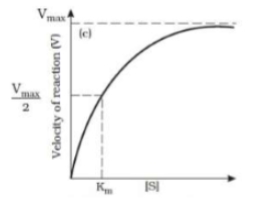Lignin is a component of the secondary walls of:-
1. Epidermis
2. Collenchyma
3. Sclerenchyma
4. Parenchyma
1. Epidermis
2. Collenchyma
3. Sclerenchyma
4. Parenchyma
Given below is the graph showing the effect of substrate concentration on enzyme activity. In the presence of a competitive inhibitor, when the concentration of the substrate is progressively increased :

| 1. | The value is increased but the reaction will not achieve |
| 2. | The value is increased but the reaction can ultimately achieve |
| 3. | The value is decreased but the reaction will not achieve |
| 4. | The value is decreased but the reaction can ultimately achieve |
Study the primary structure of a part of a hypothetical protein and choose the correct statements:
l. 1 is Serine
ll. 2 is sulfer containing amino acid and can be methionine
lll. 3 is aromatic amino acid and can be tyrosine
lV. 4 is an acidic amino acid
1. l, ll and lll only
2. l, lll and lV only
3. ll, lll and lV only
4. l, ll, lll and lV
The compound shown below:
| 1. | is a component of ATP molecule |
| 2. | is most commonly found in ori region of DNA |
| 3. | can have enzymatic activity |
| 4. | may be a component of cell membrane |
The zwitterion is shown by:
| 1. | Only A | 2. | Only B |
| 3. | Both A and C | 4. | A, B and C |
The four elements making 99 % of living system are:
(1) CHOS
(2) CHOP
(3) CHON
(4) CNOP
Glycogen is a polymer of:
(1) Galactose
(2) Glucose
(3) Fructose
(4) Sucrose
An enzyme brings about:
(1) Decrease in reaction time
(2) Increase in reaction time
(3) Increase in activation energy
(4) Reduction in activation energy
The backbone of a DNA molecule is formed by:
(1) nitrogenous bases
(2) deoxyribose sugar
(3) phosphate groups
(4) alternate sugar and phosphate moieties
A glycosidic bond connects:
(1) two monosaccharides
(2) two amino acids
(3) two fatty acids
(4) a fatty acid and a glycerol









